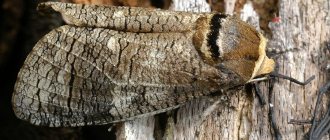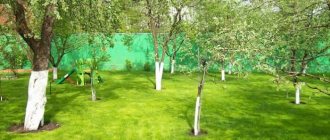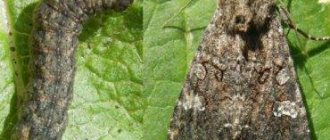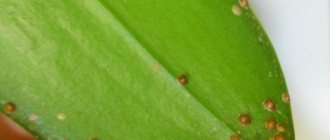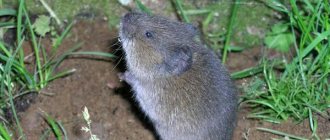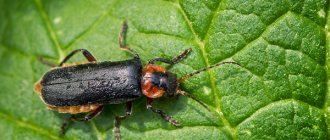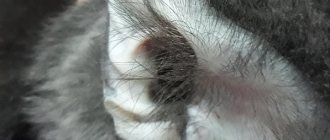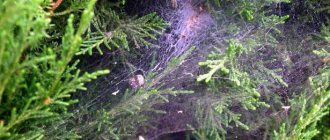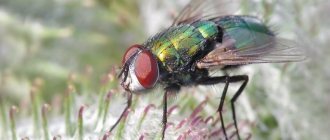Strigun beetle - How to deal with harmful beetles? Tips for their destruction on the site +Video
The snow beetle is a dangerous insect in a summer cottage.
With the development of agriculture, this type of beetle began to predominate. We will tell you in detail about what dangerous beetles there are and what they eat in our article. The appearance of the strigun is very unsightly. The length of the insect does not exceed 2-3 cm. The head, in relation to the body, is very large and twice as large. The massive jaws begin to actively move when you pick up the beetle.
Sometimes this insect is confused with the May beetle. But these two types are completely different. The snow beetle does not fly and appears in garden plots already in mid-April.
What they look like
The size of adult individuals is 2-3.5 cm. Male insects are much larger than females. A characteristic feature of the beetles is their large head, which smoothly turns into the chest. Powerful jaws stand out on the head. Males also have fangs.
Almost 1/3 of the body of insects falls on the convex abdomen. Beetles don't have wings. Insects live underground, do not fly, but crawl. The chitinous cover of the body is black with a blue tint. The body of insects rests on short legs with claws.
Snow beetles lay large larvae. They hatch into thick caterpillars with a dark head and off-white body. The length of the caterpillar can reach 4 cm. Upon completion of their development cycle, they pupate. They spend the winter in this state. The period of transformation of caterpillars into beetles is May.
Characteristics and description of the black beetle
Large beetles are mainly nocturnal, but they can also be found during the day. Swifts live in burrows, which are located in fields, steep slopes and ravines. The larvae of snow beetles are also found underground. They appear on the surface only after they have fully matured.
Strigun beetle, why it is dangerous for humans
This beetle is popularly called virgin grass and kravchik. Having appeared on a summer cottage, this parasite destroys all plantings. Strigun is an insidious insect. And in almost a couple of days he is able to eat all young plantings, seedlings and even small shrubs.
As for humans, this type of insect is safe. He does not attack people, much less cut his hair, as many people believe. Few people know that beetles do not attack first; aggression is justified by a defensive reaction to external factors.
ATTENTION! Just 4 beetles can clear a garden area of 10 m2 of greenery.
If you do not take the necessary measures in time, you can lose most of the harvest. The situation is further complicated by the fact that it is almost impossible to detect the beetle before its active impact.
Strigun beetle development cycle
Insects of this species can bite through stems twice their thickness. They can also climb to heights of more than a meter and eat leaves and young shoots. The snow beetle forms broken greenery into small cubes, moistening them with its saliva. Thereby preventing the processes of decay. He drags the resulting silage lumps into a hole for offspring.
A female snow beetle lays up to 20 eggs per season. The larva will hatch two weeks from the start of laying. They are white in color and up to 40 mm long. The larva also has a clearly defined head. As the larva grows, it begins to molt, about 3 times until it reaches full maturity. Feeding on the supplies brought by the adults, the larva turns into a pupa. After 2-3 weeks, a full-fledged beetle will hatch from it.
Due to the fact that the snow beetle insect spends a large amount of time underground, it is difficult to detect and exterminate, but there are ways to combat it.
Strigun beetle - life expectancy
It's not just summer residents who are afraid of snow beetles. Their larvae are hunted by flies, skin beetles and little ones. And the beetles themselves hide from ticks, rooks and jackdaws.
The lifespan of a snowbird does not allow it to live permanently in a hole. On the contrary, in a short period of time the female must lay eggs, provide the young with nutritious greens and protect her larvae. In addition, several families of these harmful insects can be located in one area. And they all actively interact with each other.
Fighting a snowbird is a difficult task. First of all, because the beetle does not fly, but sits deep in the hole. Therefore, chemicals are not very helpful in controlling pests. But summer residents have found several ways to destroy beetles, but we will talk about this below.
Habitat and lifestyle
Black beetles with mustaches, Striguns, in Russia live mainly in warm southern regions, in the steppe. Crawlers live where there is an opportunity to lay eggs. For masonry are used:
- grapevines;
- thickets of bushes;
- fallen, cut down trees;
- root system of trees;
- arable land;
- uncultivated, abandoned areas;
- clearings, clearings;
- forest areas damaged by fire;
- soft soil of personal plots and vegetable gardens.
For information! For their ability to dig holes in hard, unplowed soil, the beetles received another name - virgin soil.
Striguns are insects with complete metamorphosis; they go through 4 stages of development in life:
- Females lay eggs in prepared chambers in the ground.
- Under favorable conditions, larvae hatch from the eggs after 3 weeks. In the larval stage they feed on hay prepared by the “parents”. The body of the larvae is soft, light-colored, covered with skin, and completely unlike the adult. The head is small, dark, enclosed in a hard chitinous capsule.
- The pupal stage lasts 2-3 weeks.
- Young insects can overwinter again in their cell. Adults emerge from their burrows from March to July, mate, and the breeding cycle repeats.
For information! Fungi that ferment grass in burrows promote digestion, rapid growth and development of larvae.
Tricks and nuances when fighting insects
So, you found a dangerous beetle on your property and don’t know what to do? We'll tell you. First of all, you need to dig a ditch around the perimeter of the entire area. Its depth should be at least 30 cm, and the walls should be smooth so that the beetle cannot escape. Place finely chopped greens treated with special preparations at the bottom of the moat. Secondly, it is worth collecting all harmful insects from the area with your hands and loosening the soil. This will destroy the entrances to the burrows and prevent the larvae from getting out.
IMPORTANT! The effect of such protective actions will not be immediate. You can completely get rid of snow beetles only after a couple of years of active struggle.
Read also: Secrets of successfully growing stromanthus at home
Gardeners offer another way to combat black beetles. It is necessary to prepare an oily solution. And fill all the entrances to the holes with it. The emulsion is prepared from 200 ml of sunflower oil and 2 liters of water. Such a solution is harmful and destructive not only for the beetle, but also for all insects, because The respiratory system is being damaged. Even if the beetle can get to the surface, it will still die. The dead bodies of large beetles are quickly eaten by ants or passing birds.
If you find beetles in your area in early spring, you can try another method of control. For example, fill the holes with boiling water. Some summer residents prepare a soap solution and treat the area twice a day, morning and evening for a week.
Do not despair if you encounter this parasite in your area.
Using all control methods, you will get rid of snow beetles forever, and your harvest will be rich and healthy. Good luck!
Barbel damage in nature and in homes
The development of a larva, so natural in nature, in a house can turn into a real disaster: species of long-horned beetles living in dry wood are distinguished by their longevity. The larva can grow in furniture for up to 5 years, grinding the wood down to butter softness. There are known cases when barbels undermined entire blocks of wooden houses.
You can determine whether there is a barbel in the furniture not only by the characteristic round holes-passages that the larva makes for itself, but also by the sound! Indeed, if you listen at night, you can hear a characteristic crunching and creaking sound. Longhorn beetles make these sounds when their hind legs rub against each other or against their shell. In the natural environment, the grinding of the barbel is intended to scare away predators and notify relatives of danger. At home, creaking, on the contrary, can attract unwanted attention to the barbel: the owner of the house should think about treating the wood against pests.
Longhorned beetles are part of the ecosystem, but even here they can sometimes cause significant destruction. Thus, the Asian longhorned beetle is considered a real scourge of forests in Europe, North America and Canada. Pests not only weaken trees, causing them to fall, but also introduce worms and fungal spores, which causes tree diseases. Despite all the efforts of scientists to find a method of biocontrol (the problem of longhorned beetles in their natural habitat is less than 30 years old), cutting down remains the most effective method. Fortunately, it is much easier to deal with barbel at home.
//beyklopov.ru/zhuki/obshie-svedeniya/zhuk-strigun.html https://sichovka.ru/vrediteli-rastenij/zhuk-usach-foto.html
How to deal with the snow beetle (kravchik, longhorned beetle)
to start fighting the snow beetle as soon as it is found on the site.
The first sign by which its presence can be determined is the stems and leaves of cultivated plants cut off like a razor.
Moreover, the pest “cuts” not only vegetable crops. He does not refuse decorative plantings: lilies, peonies and other garden flowers. It also damages young shoots of grapes, currants and other fruit bushes and trees.
How to recognize the snow beetle
The insect reaches a length of about 2.4 cm, has a rounded, slightly oblong body, which consists of two segments: a back protected by a dense black shell and a large head with developed upper jaws. The beetle cannot fly, since the elytra are fused in the center, but it has very strong long legs, on which the insect quickly moves along the ground.
It feeds on leaves, buds and young shoots. If you don’t take measures to combat the grasshoppers, in 3-4 years they will fill the entire area, and then it will be almost impossible to survive them from the garden.
Why are kravchiki dangerous?
In the minks, the greenery obtained from the surface of the earth is impregnated with a special composition secreted from the salivary glands of the snowbirds, and is stored in chambers designed for this purpose. A fermentation process occurs in the green mass, and it turns into silage, which the offspring of snowbirds subsequently feed on.
Methods of combating the snow beetle
The entrance to the burrow's burrow is immediately noticeable; it is a regular-shaped hole with a diameter of about 1.5 cm. The fight against the snow beetle should be concentrated near the burrows.
There are several folk methods of how to destroy striguns. Firstly, this is sunflower oil . You can buy the cheapest oil of low quality, dilute it with water, mix well, and pour it into the burrows. The oil prevents air from penetrating into the hole, and the insects crawl out in a half-dead state, where they can be easily caught and destroyed.
Striguns can also be dug up . Having found a hole, stick a shovel at a distance of 10 cm from it and turn out a lump of earth. As a rule, a beetle is almost always found on a shovel, which is simply choked by shoes.
Since beetles do not fly, they enter the area by moving along the soil. Having made a 30 cm deep ditch around the garden, you can collect the uninvited “guests” that fall into it with your hands.
Complex control of insect pests includes loosening the soil, destroying the entrances to burrows.
Insecticidal agents are ineffective in combating minks, since the pests are located deep underground (sometimes minks reach 70 cm in length). But chemicals are used to spray the edges of the area to create a barrier for migrating insects. Also, the grass is treated with store-bought preparations and laid out in grooves dug around the perimeter of the garden.
Snow beetles are tenacious, and it is quite difficult to remove them from the garden. It is possible to achieve an effect if you start fighting them on time and apply methods to destroy them in a complex manner.
The pest is the Strigun beetle or Kravchik beetle. Strigun beetle control methods.
A real disaster may come to the residents of the south: the Strigun beetle, also known as the Kravchik beetle.
You may never have encountered a snow beetle before and may not know anything about it. Well, bugs, well, they crawl. Black, unusual. They are very fussy and always backing away somewhere. Until you notice what they are doing in your domain. It’s difficult to say where they come from in gardens, because they are pests that live in virgin lands; they don’t like arable land. But as practice has shown, they absolutely do not care where to dig holes, as long as there is vegetation nearby.
Strigun beetle or Kravchik beetle. Strigun beetle control methods.
The snow beetle will appear at the beginning of spring, and in a friendly black crowd they will quickly run through the beds, cutting off weeds. As soon as the first shoots emerge, you will be horrified and clutch your head. The beetle beetle will destroy almost all seedlings. He has no preference for any particular varieties, but cultivated plants taste better to him. The snow beetle is omnivorous; it does not disdain onions and garlic, something that ordinary pests avoid. When the carrots sprout, the crab beetle will attack it, and then spread to everything that gets in its way. You will watch how they hide in their holes when you walk through the garden, how they will rest and bask in the sun. But their main job is to accumulate enough food for their offspring. They are called model parents and are very fertile. Next spring, if the beetle has managed to leave for its wintering place, more than twenty individuals will crawl out of one hole. The matter is further complicated by the fact that the snow beetle is not destroyed by birds - its shell is too hard, chemicals will not help either, weak poisons do not kill it. There are very few methods to combat the snow beetle (kravchik beetle), and they are practically ineffective. On various sites you can find the following tips and recommendations on how to destroy the snow beetle:
- Strigun beetle control methods: collect by hand. Pointless. In a couple of days, there will be a three-liter jar of swifts, and their population will not decrease at all. This is impossible to do on a large area. Especially if your fence is not a hindrance for them, and they can crawl under it from neighboring gardens or dachas, where there is uncultivated land. This method of combating the red beetle is not very effective due to the large amount of time required and the large area to be treated.
- Strigun beetle control methods: – use of oil. Unrefined oil is added to a bottle of water, and this mixture is poured into the burrows. According to the instructions, the beetle suffocates and crawls out. If the females managed to lay larvae, they will die of hunger when they hatch, because the parents did not have time to prepare the required amount of grass for it. However, the volume of oil to treat a large area will significantly empty your pocket. There will be little result - in search of food, the red beetle will crawl from neighbors or from virgin lands.
- Krawczyk beetle control methods. Treat with strong chemicals. This method is a big question; after all, vegetables are grown for the family, and everyone will want to serve poisonous foods to the table.
- Strigun beetle control methods. Dig up your area, make a kind of trench so that they fall into it and do not crawl towards you. This is possible, but it is much better if the metal profile fence is slightly deeper into the ground. The beetle beetle cannot fly; it only crawls; it cannot climb a sliding surface. You can cover the gaps between the fence and the ground with something that the red beetle cannot cross.
So, if a solid fence is an insurmountable barrier for him, what to do with those who have already settled on the perimeter? Grape shoots can be fenced with plastic bottles by cutting them and wrapping them around the trunk, covering them with a little earth so that it does not fly away. A bed with strawberries - border tape. Aluminum cans will also work. The snow beetle is very fond of grapes and strawberries. But the Strigun eats everything, indiscriminately. If you don't take action, you won't have roses or peonies, which are one of your favorite delicacies. The beetle beetle will cut them off first. If the seedlings were in a plastic cup, you can cut off the bottom and plant it in this form, provided that the size of the future plant will allow this option. This will protect the stem from the shoot. Yes, the snow beetle has very powerful jaws and is tough on a young trunk, but it always chooses the top. Our task is to make sure that he does not reach it. You can dig up the beds so that they are higher than the path. The beetle won't be able to climb up a steep earthen wall either. You can use old unnecessary boards to make a kind of border, placing the board on its edge. A strigun can crawl up a tree, but most likely will fall back under the weight of its body. Having divided the garden into several such zones, the beetle can easily be collected, because new individuals will not crawl into the fenced area, and sunflower oil will act more effectively. Another way of fighting is to pour boiling water into their burrows. This is one of the most useless methods. It's not worth wasting time on it.
The snow beetle will pester you only until June. As soon as real summer arrives, the grass will go deep into the ground, leaving behind almost half of what you planted. The most effective method of combating the snow beetle is to dig up the ground in late October - early November. Although they dig holes one meter deep, with drainage and rooms, digging breaks them, and the snow beetle and its larvae freeze and die. It is best to use a tractor for this. Such services are provided and are relatively inexpensive.
If your garden is attacked by the snow beetle, fence off everything that can be fenced off, then you can isolate the plants from this black scourge and collect them with your hands or fill the holes with oil. It seems that the beetle beetle should not touch peppers and cucumbers, but it eats them with pleasure. Therefore, fence off everything you can. And be sure to dig up the ground in the fall, with the onset of the first cold weather. Try to get rid of the beetle by all available means, it can cause a lot of trouble. I hope that all these methods of dealing with the beetle will help you get rid of the evil pest, and the beetle will never bother you again.
A little bit of biology
Longhorned beetles have fairly small sizes (from one to several tens of millimeters), a flat body and mustaches, which are the main organ of smell. The color of lumberjacks is usually brown or dirty gray; less commonly, the longhorn beetle is black. The photo allows you to examine the insect in more detail.
The larvae of the pest are characterized by particularly powerful jaws, thanks to which they can handle both hard wood and soft metal with a cable-type coating. However, the beetles do not eat the latter so readily, preferring wooden structures and stacked boards.
Read also: Algorithm for using disinfectant solution, precautions and storage
The female barbel lays her eggs (from 200 to 400 pieces) in recesses or cracks in the tree, and after 7-14 days the larvae are born, which instantly activate the process of destroying the tree.
It is worth emphasizing that it is almost impossible to immediately notice a tree disease, since the larvae lead a hidden lifestyle. So, you can understand that your wooden house has succumbed to the harmful effects of longhorned beetles only when the real results of their work (destroyed and loosening wood) are visible.
Features
The woodcutter beetle has a number of characteristic features that distinguish this type of pest from many others. These include:
- Long mustache. The longhorned beetle has prominent whiskers that are 2-5 times longer than the insect itself.
- Slender and elongated body. The length of the body varies from 3 to 60 mm.
- Wings. Some species of woodcutter beetles can fly.
Description and features
This remarkable insect belongs to the order Coleoptera. Such creatures got their name for their special love for wood, which usually serves as their home. They feed on it, which causes colossal damage to the entire surrounding space, in particular to buildings and human property.
The woodcutter beetle is a multifaceted creature that has spread almost everywhere, with the exception of perhaps the coldest regions of the planet. A particularly impressive and noticeable part of his appearance is his segmented huge mustache, the length of which exceeds his own body size, sometimes several times.
The body of the insect itself is slender and elongated. It can be black-brown or black. In nature, there are also gray-blue beetles, pale yellow and completely white. There are specimens with a greenish color with the addition of metallic or pearlescent shades.
The upper part of such creatures can be decorated with an interesting ornament; they can stand out and be full of colorful stripes, bands and spots. All the features of the external appearance can be seen in the photo of the woodcutter beetle .
This creature also has wings, which in some cases can be very useful, because some varieties of such beetles are naturally endowed with the ability to fly. True, not everyone can move in the air quickly, easily and gracefully; especially large specimens are famous for their considerable clumsiness at such moments.
It is quite easy to distinguish the female individual of the described creatures from the male. The latter are usually noticeably smaller. And large females are also distinguished by their bright body colors and significant mustache size.
Many varieties of such beetles are endowed with the unpleasant ability to make creaking, sharp noises resulting from the friction of various parts of the body of this insect. Sometimes these sounds are not accidentally, but are specially reproduced by such creatures.
In most lumberjacks, the length of the whiskers can exceed the length of the beetle's body
In this way they scare away their enemies, and in some cases it serves as a threatening signal before an attack.
Where can I meet you?
The longhorned beetle can live and reproduce not only in various tree species, but also in shrubs and herbaceous plants. Longhorned females lay their eggs in a crack in tree bark, in depressions on branches, trunks or stems. Moreover, the pests make these cracks and gouges themselves.
Lumberjacks can “visit” you at your dacha, and the forestry industry can “boast” of such guests. In country houses, the objects of pest attack are furniture, boards and other wood products.
History of the origin and classification of the longhorned beetle
Fossil representatives of longhorned beetles inhabited the earth back in the Jurassic period, and now the number of the family of these beetles is about 26,000 species - and this is not the limit! Previously unknown species of longhorned beetles are regularly discovered (most often, discoveries occur in tropical and equatorial regions, but sometimes unstudied longhorned beetles are also found in Europe). The distribution of longhorned beetles is associated with their main food - wood. In Russia alone, about 583 species of longhorned beetles are known, and in Ukraine - about 280. In our forests, the following types of longhorned beetles can most often be found:
- large spruce black;
- large and small coniferous;
- black fir;
- velvet spotted;
- pine;
- mottled.
Important!
It has been scientifically proven that different species of longhorned beetles may well interbreed with each other - scientists often record the occurrence of hybrids, for example, mating between different species of the genus Dorcadion (root beetles). So the population of these beetles is constantly increasing. At the same time, the barbel family among Coleoptera is one of the most studied.
What to do if you find a barbel at home?
If a mustachioed pest is found in the house, then an emergency response is necessary. Why? It’s just that if this insect gets into wood, which is the main material of your home, then it will not calm down until it eats it or, as they say, if it doesn’t eat it, it will spoil it, causing significant damage to the building as a whole.
The longhorned beetle is not dangerous to humans, but it can harm him by destroying his home. To ensure that your home doesn’t care about insects, the wood should be treated during the construction stage. There are several ways to protect wood. Fumigation using phosphine gas is considered the most effective and optimal. This method of wood processing is held in high esteem by both owners of wooden buildings and carpenters, who process each unit individually.
A longhorned beetle visited your house and settled in it - a problem whose solution consists of the following actions:
— Assess the degree of damage to the material. To do this, you need to take a screwdriver and try to pierce the tree. If the tool enters easily, then it is impossible to do without eliminating a separate section of the surface of the house or the structure of the wood material (rafters, frames, beams). This is direct evidence that your house, or certain elements of it, is being eaten by a longhorned beetle. See photo of the damaged wooden beam below.
Hard wood can be left, but subjected to special treatment.
— Prepare the structure for the processing process. Clean the surface of the wood using a brush with increased rigidity. In this case, the person involved in this process must have special equipment: a respirator, glasses.
— Remove the dust layer with a vacuum cleaner.
- Coat the wooden surface with insecticide. Irrigate even surfaces, but intensively moisten holes and cracks with the product.
— Close all door and window openings in the room for several hours (usually 34 hours).
— If the wooden surface is open, it must be systematically treated with hot drying oil. It is worth remembering that this option is far from the best, because when processed with such material, the original texture of the material is subject to change.
- Resort to the use of special products that penetrate deeply into the tree and are distinguished by a long period of preservation of their properties: “Antizhuk”, “Empire-20”, “Antishashelin”.
— Treat the tree with antiseptics once every 12 months. It is best to do this in the month of June.
— Treat affected areas of wood with carbon disulfide.
— Expose the affected tree to high temperatures (within 74 degrees). This can be done with a specially designed device, which will not be difficult to find and purchase.
Longhorned beetle: how to get rid of it?
Special means of varied action will help you fight barbels in your own home. Which specific product to choose in this or that case is entirely up to you!
Read also: Instructions for using “Virosalm” for pigeons
Conventionally, such funds can be divided into three groups:
- Contact. They manifest their effect directly upon contact with the longhorned beetle. Such products are not popular because their use can be harmful to human health.
- Intestinal. Such agents include sodium fluoride, zinc chloride and other components that exert their harmful effects on the insect through the intestines.
- Fumigants. These are gaseous and vaporous substances: sulfur dioxide, dichloroethane, etc.
Remember that solid wood, on the surface of which there are no cracks or other defects, is not of interest to pests. The longhorned beetle will live and reproduce only in cracks. Therefore, you can’t go wrong if you pour a special product into the grooves of the wood panel with a syringe, and then cover these holes with wood putty or ordinary plasticine.
Remember that it is very difficult to overcome barbels! It is much easier to resort to preventive methods, for example, using exclusively wood impregnated with fungicides for construction purposes.
What a lifestyle
Beetles begin to be active in April, when it becomes warm outside, and in some regions even in March. They go out and start digging holes. With each season, a new orca is definitely needed; the crab beetle will not live in the old one. Approximate depth 15-20 centimeters. It is in this den that he eats the cut stems.
As soon as the food supply near the house runs out, the insect moves to another place. Most often he cuts grass and woody vegetation. Absolutely polyphagous and therefore poses a great danger to agricultural crops.
Read on topic:
Features of the life activity of ladybugs
14.11.2020
Description of chironomids and their possible danger to humans
14.11.2020
What do cutworms look like and what harm do they cause?
14.11.2020
What do goliath beetles look like and can they be bred at home?
14.11.2020
This is interesting!
The longhorned beetle family includes not only annoying wood pests, but also representatives of the Red Book of Russia. One of them is the relict longhorned beetle (woodcutter). Its habitat is the deciduous forest of the Far East. A distinctive feature is the body length, reaching 11 centimeters. Meeting such a beetle is a great success. The titan lumberjack, which has received the status of “the largest beetle on the planet,” and the long-legged harlequin, whose front limbs are longer than the length of the body, also need protection.
Nutrition
It is already clear that the nutrition of such insects is directly related to trees, most often pine needles. The woodcutter beetle capable of feeding on plant pollen and leaves. However, much depends on the habitat of such insects and, as can already be concluded from the above, on the variety.
Often the very name of representatives of a certain species speaks volumes about the preferences of these creatures. For example, the bark beetle loves to feast on bark. But being a gourmet, he chooses fresher delicacies, devouring young branches with insatiability.
Scientists believe that the substances that beetles receive on such a diet have a beneficial effect on the formation of germ cells that mature in the body of such insects. Well, the house woodcutter likes to settle in people’s homes and cause them a lot of trouble, feeding on house wood.
There are also more harmless varieties of such beetles; they feed on tree sap and flower nectar. And some species of these insects in adulthood completely refuse food.
These include the titanium barbel. For mature individuals, the reserves that they received in the form of nutrients at the larval stage are usually sufficient. They themselves, having reached maturity, live no more than a few weeks and the purpose of their existence is solely to fulfill their reproductive role.
Tselinnik, Strigun, Kravchik
Large beetles, reaching 3.5 cm in length , prefer to live on untouched lands, but with the development of agriculture and human occupation, more and more land areas are settling in the vicinity of cultivated areas, which makes it easier for them to find food.
The head is flattened, large with a straight line connecting the forehead and clypeus, with a pair of cheek protrusions located at the edges of the eyes.
In front of the eyes there is a pair of hard antennae, at the ends of which there are brush-like thickenings. Males have fang-shaped hard processes on the jaw, which males use to win the right to mate. The mandibles, covered with short hairs, are hidden between the biting fangs. In females, the jaw processes are smoothly rounded and have no fangs.
The Strigun has three pairs of tenacious and strong limbs, which are covered with stiff hairs, and there are claws at the ends of the paws.
The wings are not developed, this species does not fly, it has hard and short, fused elytra.
Snow beetle photo
The second name of the insect is kravchik. The main habitat is the northern Steppe and southern Polesie. The diet of an adult individual consists of cultivated and wild plants, tree shoots, and grapevines.
A characteristic feature of the swifts is their large head and large jaw apparatus. The presence of a pest in an area can be identified by the characteristic burrows that adults dig for themselves and the larvae as a refuge. Before breeding, the female and male establish a shelter at greater depths with winding passages.
The snow beetle in the photo has a number of distinctive features
- flattened large head;
- a pair of eyes on the sides;
- straight line from the clypeus to the forehead;
- antennae with brush-like thickenings at the end;
- fang-shaped jaw processes for fighting for the female and intimidating the enemy - in males;
- wide powerful chest, rounded abdomen;
- durable chitinous shell of matte black color or with a blue sheen;
- three pairs of legs with claws and setae;
- wings are absent, elytra are rigid and fused.
The beetle's forelimbs are adapted for digging and are equipped with 6 teeth.
With their help, the insect forms a burrow in which it lays eggs, overwinters and stores food for its offspring. Reduced wings do not allow the swifts to move through the air. The powerful jaw apparatus is the main means by which the adult individual destroys vegetation in large quantities. It can bite through even thin woody plants. The insect takes the cut shoots into the hole and compacts them. The leaves and stems rot into silage, which serves as the main food for larvae and adult beetles.
In the wild, snowbirds choose uncultivated areas with dense soil (ravines, fields, steppe slopes) as their habitat.
Harm and danger
The snow beetle is more than dangerous for cultivated plantings because it multiplies quickly and quantitatively. One female lays eight to ten eggs in a clutch, but this is only one burrow. Several of these burrows per square meter pose a real threat to vegetation covering an area ten times larger.
To provide their offspring with food, the beetles cut off with their powerful jaws literally all the greenery in their path: stems, foliage, buds with inflorescences, even green, non-lignified grapevines.
Who is the snow beetle and how to get rid of it
The snow beetle is an insect that can cause serious damage to a summer cottage or farm. It is also known as kravchik, strigunets, virgin grass, golovach.
It is no coincidence that the pest received its name, because in Ukrainian “kravchik” means “tailor”.
The insect, as when cutting clothes, cuts off the plant at the root with its powerful jaws, including even shrubs and vines.
The pest feeds on both garden crops and garden, ornamental plants and even tree shoots.
Attention! The fight against the insect must begin immediately after its appearance, otherwise a significant part of the garden plot will be damaged.
Why the snow beetle is dangerous for nature and humans
Living in the wild, the snow beetle does not pose any danger. But, having appeared on a plowed field, garden or vegetable plot, the insect becomes a serious pest of agricultural crops and other green spaces.
Having appeared on a personal plot, insects living in 2-3 burrows are capable of destroying plants on an area of up to 5-7 square meters. m. At the same time, pests destroy almost everything in their path - from carrots and corn to strawberries and vineyards.
Krawczyk never attacks a person first. On rare occasions, sensing danger is approaching, he may lightly pinch his skin. Snow beetle bites are not dangerous, but quite unpleasant.

